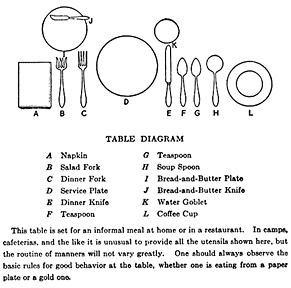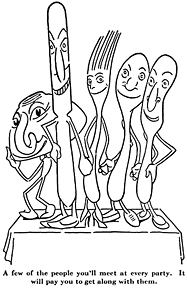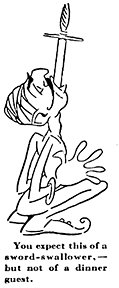Here’s the second installment in our look at Manners for Moderns, a 1938 etiquette guide for young men.
II
MEET AND DRINK
| It is very nice to think The world is full of meat and drink. |
| — R.L. STEVENSON |
Eating is the one social activity which is common to everybody in all lands. Table manners grew out of the fact that unless he is eating in a room empty of all but himself, a man eats in company and food is less appetizing if the other fellow’s table manners are sloppy and disgusting. It matters little what sort of food is being served, whether the table is loaded with priceless silver and china or tin and graniteware; the simplest meal is made more attractive by the use of good table etiquette.
Correct table manners are really so simple and so often important as a guide to the character of the individual that every man owes it to himself to acquire them.
After seating yourself at the table, unfold your napkin and place it across your knees.
Do not shake it out as though you were trying to flag a train, or tuck it under your collar, tie it around your neck, or anchor it under your belt.
The functions of a napkin are to remove crumbs or grease from around your lips, to wipe your fingers, and to protect your lap from dropped food. After the meal, place your napkin in loosely gathered folds beside your plate.

Silverware is always placed with forks to the left of the service plate, knives and spoons to the right of the service plate. Knives are laid with the cutting edge toward the center of the plate and forks are placed with tines up.
Silver is arranged in the order in which it will be used, beginning at the outside and working toward the plate.
The cocktail fork or spoon is generally placed on a small plate holding the cocktail glass. The cocktail fork may already be on the table–at the left of the service fork. A spoon may be used with fruit cocktail. After using it, lay your cocktail fork or spoon on the small plate beside the cocktail glass.
The knife is used to cut food and to butter your bread, if no bread-and-butter knife is provided. When you are not using your knife for cutting, place it across the upper edge of your plate with the cutting edge toward the center of the plate.
Do not use it for putting any food in your mouth, or place it with the tip at the plate and the handle on the tablecloth. It might slip off and soil the cloth.
When cutting meat, cut only one or two bites at a time, lay your knife down, eat these, and then cut more as you need them. A plate littered with small pieces of meat and vegetables stirred into a hash looks as though a grenade has exploded in its middle. It is not an attractive sight to your neighbor.
| Remember: Never place your knife in your mouth. |
Food is placed in the mouth with the fork. Eat all the food on the large plate with the fork,–never with a knife or spoon. Never pile up a mound of food on the back of your fork with your knife.
Read More »


